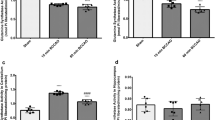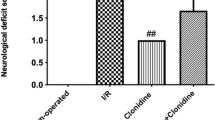Abstract
Rats were treated with alpha-methyl-para-tyrosine (AMT, 250 mg/kg, i.p), an hydroxylase inhibitor, in order to decrease brain levels of catecholamines. Six hours later, when cerebral dopamine (DA) and norepinephrine were reduced by about 80%, a transient forebrain ischemia of 30 min duration was induced by four-vessel occlusion technique. Evaluation of brain damage 72 hours after ischemia showed that AMT treatment significantly decreased neuronal necrosis in the striatum but had no cytoprotective effect in the CA1 sector of the hippocampus and in the neocortex. AMT treatment reduced mortality within the ischemic period but did not affect either the mortality within the recirculation period or the postischemic neurologic deficit. These results suggest that the striatal cytoprotective effect of AMT is linked to cerebral DA depletion and that excessive release of DA during ischemia or dopaminergic hyperactivity during recirculation play a detrimental role in the development of ischemic cell damage in the striatum.
Similar content being viewed by others
References
Wieloch, T. 1985. Neurochemical correlates to selective neuronal vulnerability. Pages 69–85,in Kogure, K., Hossmann, K.A., Siesjö, B.K., and Welsh, F.A. (eds), Progress in Brain Research, Vol 63, Elsevier Science Publishers.
Rothman, S.M. 1984. Synaptic release of excitatory amino acid neurotransmitters mediates anoxic neuronal death. J. Neurosci. 4:1884–1891.
Slivka, A., Brannan, TS., Weinberger, J., Knott, PJ., and Cohen, G. 1988. Increase in extracellular dopamine in the striatum during cerebral ischemia: a study utilizing cerebral microdialysis. J. Neurochem. 50:1714–1718.
Hillered, L., Hallström, A., Segervärd, S., Persson, L., and Ungerstedt, U. 1989. Dynamics of extracellular metabolites in the striatum after middle cerebral artery occlusion in the rat monitored by intracerebral microdialysis. J. Cereb. Blood Flow Metabol. 9:607–616.
Ogura, K., Shibuya, M., Suzuki, Y., Kanamori, M., and Ikegaki, I. 1989. Changes in striatal dopamine metabolism measured by in vivo voltammetry during transient brain ischemia in rats. Stroke 20:783–787.
Damsma, G., Boisvert, D.P., Mudrick, A., Wenkstern, D., and Fibiger, H.C. 1990. Effects of transient forebrain ischemia and pargyline on extracellular concentrations of dopamine, serotonin, and their metabolites in the rat striatum as determined by in vivo microdialysis. J. Neurochem. 54:801–808.
Obrenovitch, T.P., Sarna, G.S., Matsumoto, T., and Symon, L. 1990. Extracellular striatal dopamine and its metabolites during transient cerebral ischaemia. J. Neurochem. 54:1526–1532.
Sarna, G.S., Obrenovitch, T.P., Matsumoto, T., Symon, L., and Curzon, G. 1990. Effect of transient cerebral ischaemia and cardiac arrest on brain extracellular dopamine and serotonin as determined by in vivo dialysis in the rat. J. Neurochem. 55:937–940.
Ahn, S.S., Blaha, C.D., Alkire, M.T., Wood, E., Gray-Allan, P., Marrocco, R.T., and Moore, W.S. 1991. Biphasic striatal dopamine release during transient ischemia and reperfusion in gerbils. Stroke 22:674–679.
Bhardwaj, A., Brannan, T., and Weinberger, J. 1991. Pentobarbital inhibits extracellular release of dopamine in the ischemic striatum. J. Neural. Trans. 82:111–117.
11.Globus, M.Y.T., Ginsberg, M.D., Dietrlch, W.D., Busto, R., and Scheinberg, P. 1987. Substantia nigra lesion protects against ischemic damage in the striatum. Neursci. Lett. 80:251–256.
Clemens, J.A., and Phebus, L.A. 1988. Dopamine depletion protects striatal neurons from ischemia-induced cell death. Life Sci. 42:707–713.
Hökfelt, T., and Ungerstedt, U. 1973. Specificity of 6-hydroxydopamine induced degeneration of central monoamine neurones: an electron and fluorescence microscopic study with special reference to intracerebral injection on the nigro-striatal dopamine system. Brain Res. 60:269–297.
Sachs, C., and Jonsson, G. 1975. Mechanisms of action of 6-hydroxydopamine. Biochem. Pharmacol. 24:1–8.
Brannan, T., Weinberger, J., Knott, P., Kaufmann, H., Togasaki, D., Nieves-Rosa, J., and Maker, H. 1987. Direct evidence of acute, massive striatal dopamine release in gerbils with unilateral strokes. Stroke 18:108–110.
Weinberger, J., Nieves-Rosa, J., and Cohen, G. 1985. Nerve terminal damage in cerebral ischemia: protective effect of alphamethyl-para-tyrosine. Stroke 16:864–870.
Wieloch, T., Koide, T., and Westerberg, E. 1986. Inhibitory neurotransmitters and neuromodulators as protective agents against ischemic brain damage. Pages 191–197,in Kriegelstein, J. (ed), Pharmacology of cerebral ischemia. Elsevier Science Publishers.
Pulsinelli, W.A., and Brierley, J.B. 1979. A new model of bilateral hemispheric ischemia in the unanesthetized rats. Stroke. 10:267–272.
Marie, C., Bralet, A.M., and Bralet, J. 1987. Protective action of 1,3-butanediol in cerebral ischemia. A neurologic, histologic, and metabolic study. J. Cereb. Blood Flow Metabol. 7:794–800.
Brown, A.W., and Brierley, J.B. 1968. The nature, distribution and earliest stages of anoxic-ischaemic nerve cell damage in the rat brain as defined by the optical microscope. Br. J. Exp. Pathol. 49:195–200.
Pulsinelli, W.A., Brierley, J.B., and Plum, F. 1982. Temporal profile of neuronal damage in a model of transient forebrain ischemia. Ann. Neurol. 11:491–498.
Anton, A.H., and Sayre, D.F. 1962. A study of the factors affecting the aluminium oxide-trihydroxyindole procedure for the analysis of catecholamines. J. Pharmacol. Exp. Ther. 138:360–375.
Beley, A., Zekhnini A., Lartillot, S., Fage, D. and Bralet, J. 1987. Improved method for determination of acetylcholine, choline, and other biogenic amines in a single brain tissue sample using high performance liquid chromatography and electrochemical detection. J. Liq. Chromatogr. 10:2977–2992.
Widerlöv, E. 1977. Dose-dependent pharmacokinetics of α-methyl-p-tyrosine (αMT) and comparison of catecholamine turnover rates after two doses of α-MT. J. Neural Transm. 44:145–158.
Widerlöv E., and Lewander, T. 1978. Inhibition of the in vivo biosynthesis and changes of catecholamine levels in rat brain after α-methyl-p-tyrosine: time- and dose-response relationships Naunyn-Schmiedeberg's Arch. Pharmacol. 304:111–123.
Jewett, S. L., Eddy, L.J., and Hochstein, P. 1988. Is the autooxidation of catecholamines involved in ischemia-reperfusion injury? Free Radic. Biol. Med. 6:185–188.
Kogure, K., Arai, H., Abe, K., and Nakano, M. 1985. Free radical damage of the brain following ischemia. Pages 237–259,in Kogure, K., Hossmann, K.A., Siesjö, B.K., Welsh, F.A. (eds). Progress In Brain Research, Elsevier Sciences Publishers.
Ginsberg, M.D., Watson, B.D., Busto, R., Yoshida, S., Prado, R., Nakayama, H., Ikeda, M., Dietrich, W.D., and Globus, M.Y.T. 1988. Peroxidative damage to cell membranes following cerebral ischemia. A cause of ischemic brain injury? Neurochem. Pathol. 9:171–193.
Bromont, C., Marie, C. and Bralet, J. 1989. Increased lipid peroxidation in vulnerable brain region following transient forebrain ischemia in the rat. Stroke 20:918–924.
Braughler, J.M., and Hall, E.D. 1989. Central nervous system trauma and stroke I. Biochemical considerations for oxygen radical formation and lipid peroxidation. Free Radiac. Biol. Med. 6:289–301.
Harsing, L.G., and Vizi, E.S. 1991. α2-adrenoreceptors are not involved in the regulation of striatal glutamate release: comparison to dopaminergic inhibition. J. Neurosci. Res. 28:376–381.
Globus, MYT., Busto, R., Dietrich, WD., Martinez E., Valdes, I., and Ginsberg, MD. 1988. Effect of ischemia on the in vivo release of striatal dopamine, glutamate, and γ-aminobutyric acid studied by intracellular microdialysis. J. Neurochem. 51:1455–1464.
Blomqvist, P., Lindvall, O., and Wieloch, T. 1985. Lesions of the locus coeruleus system aggravate ischemic damage in the brain. Neurosci. Lett. 58:353–358.
Davis, J.N., Nishino, K., and Moore, K. 1989. Noradrenergic regulation of delayed neuronal death after transient forebrain ischemia. Pages 109–116,in Ginsberg, M.D., Dietrich, W.D. (eds.), Cerebrovascular Diseases, Raven Press, New York.
Araki, T., Kogure, K., and Izumiyama, K. 1989. Prevention of ischemic neuronal damage by α 1-adrenoreceptor agonist (methoxamine). Acta Neurol. Scand. 80:451–454.
Gustafson, I., Miyauchi, Y., and Wieloch, T.W. 1989. Postischemic administration of idazoxan, an α 2 adrenergic receptor antagonist, decreases neuronal damage in the rat brain. J. Cereb. Blood Flow Metabol. 9:171–174.
Peterson, S.L., and Albertson, T.E. 1982. Neurotransmitter and neuromodulator function in the kindled seizure and state. Prog. Neurobiol. 11:491–499.
Dampney, R.A.L., Kumada, M., and Reis, D.J. 1979. Central neural mechanisms of the cerebral ischemic response. Characterization, effect of brainstem and cranial nerve transections, and stimulation by electrical stimulation of restricted regions of medulla oblongata in rabbit. Circ. Res. 44:48–62.
Kubo, T., Amano, H., Katsumata, M., and Misu, Y. 1985. Involvement of central catecholamines in mediation of pressor response of the rat to carotid occlusion. Naunyn-Schmiedeberg's Arch. Pharmacol. 328:348–350.
Author information
Authors and Affiliations
Rights and permissions
About this article
Cite this article
Marie, C., Mossiat, C., Beley, A. et al. Alpha-methyl-para-tyrosine pretreatment protects from striatal neuronal death induced by four-vessel occlusion in the rat. Neurochem Res 17, 961–965 (1992). https://doi.org/10.1007/BF00966821
Accepted:
Issue Date:
DOI: https://doi.org/10.1007/BF00966821




